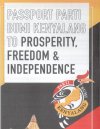The formation of the Federation of Malaysia on September 16, 1963, was a pivotal moment in Southeast Asian history, uniting the Federation of Malaya with the British Crown Colonies of North Borneo (Sabah), Sarawak, and Singapore. However, the historical narrative surrounding this event is far from monolithic.
For decades, the legitimacy and fairness of the process have been subjects of intense debate, particularly within Sarawak and Sabah. This article delves into the controversies surrounding the formation of Malaysia, examining the roles of the Cobbold Commission, the legality of the Malaysia Agreement 1963 (MA63), the absence of a popular referendum, and the geopolitical undercurrents that shaped the federation's creation. Drawing from a range of sources, including official reports, declassified documents, and critical analyses, this paper aims to provide a comprehensive overview of a history that continues to influence contemporary political discourse in Malaysia.
The Cobbold Commission: A Flawed Mandate?
In 1962, the British and Malayan governments established the Cobbold Commission, a Commission of Enquiry, to ascertain the views of the peoples of North Borneo and Sarawak on the proposed Malaysian federation. The Commission's official report, published on August 1, 1962, concluded that a majority of the population was in favor of the merger, paving the way for the signing of the Malaysia Agreement. However, the Commission's methodology and findings have been heavily criticized for their lack of democratic legitimacy.
Methodology and Findings
The Commission, headed by the former Bank of England governor, Lord Cobbold, comprised two British and two Malayan representatives, with Lord Cobbold as chairman. Notably, there were no representatives from either North Borneo or Sarawak. The Commission spent two months touring the territories and, according to its report and subsequent analysis, interviewed approximately 4,000 people [1, 2]. This figure, representing less than one percent of the combined population of over one million at the time, has been a central point of contention.
The Commission's findings famously divided the population's views into three thirds:
About one-third of the population of each territory strongly favours early realisation of Malaysia without too much concern about terms and conditions. Another third, many of them favourable to the Malaysia project, ask, with varying degrees of emphasis, for conditions and safeguards... The remaining third is divided between those who insist on independence before Malaysia is considered and those who would strongly prefer to see British rule continue for some years to come. [3]
Based on this assessment, the Commission concluded that the formation of Malaysia should be implemented. However, critics argue that this interpretation glossed over significant opposition and a widespread desire for self-determination before any merger was considered.
Critical Flaws
The process undertaken by the Cobbold Commission was fraught with methodological issues that cast doubt on the validity of its conclusions.
|
Flaw |
Description |
|
Unrepresentative Sample |
Interviewing only ~4,000 people out of a population of over one million is statistically insignificant and cannot be considered a genuine reflection of popular will. |
|
Lack of Bornean Representation |
The absence of any members from North Borneo or Sarawak on the Commission itself is a glaring omission, leading to accusations of it being an "Anglo-Malayan exercise" [2]. |
|
Language and Cultural Barriers |
There is no evidence that the Commission members spoke the numerous local and indigenous languages, raising questions about how accurately they could have gauged the opinions of the non-English-speaking rural population. |
|
Climate of Intimidation |
Sources indicate that the political climate was suppressive. Those who openly opposed the Malaysia plan were often labeled as "subversives" or "communists" and faced arrest and persecution [2]. This climate of fear likely prevented many from expressing their true opinions. |
Even the British Governor of North Borneo at the time, Sir William Goode, reportedly called the entire exercise "a farce" in private [2], a sentiment that underscores the deep-seated skepticism surrounding the Commission's work.
The Missing Referendum
A cornerstone of the criticism against the formation of Malaysia is the complete absence of a referendum. In an era of decolonization, the principle of self-determination, as enshrined in United Nations resolutions like UNGA 1514, was paramount. Yet, the people of Sarawak and North Borneo were never given the opportunity to vote directly on their future. The Cobbold Commission's enquiry, with its limited and selective interviews, was presented as a substitute for a popular vote.
This was further compounded by the role of the United Nations Malaysia Mission (UNMM), dispatched in August 1963 to conduct a final ascertainment of the people's wishes. The UNMM was not a referendum; it was another rapid assessment mission. Its legitimacy was severely undermined when the Tunku Abdul Rahman, Prime Minister of Malaya, announced on August 29, 1963, that the Federation of Malaysia would be established on September 16, 1963—before the UN mission had even completed its work. UN Secretary-General U Thant himself expressed his dismay:
This has led to misunderstanding, confusion, and even resentment among other parties to the Manila agreement, which could have been avoided if the date could have been fixed after my conclusions had been reached and made known. [4]
For many critics, the Cobbold Commission and the subsequent UN Mission were little more than "window-dressing exercises" [5] designed to legitimize a predetermined political outcome.
The Legality of the Malaysia Agreement 1963 (MA63)
The Malaysia Agreement 1963, the international treaty that created the federation, is another focal point of legal and political contention. The core of the controversy lies in the status of its signatories and the circumstances under which it was signed.
An Agreement Between Unequals?
MA63 was signed by five parties: the United Kingdom, the Federation of Malaya (an independent nation), and the three British colonies of North Borneo, Sarawak, and Singapore. Proponents of Sarawak's independence argue that the agreement is void ab initio (invalid from the beginning) because an independent nation cannot legally enter into a binding international treaty with territories that are still under colonial rule and lack sovereignty [6]. This perspective holds that the colonies did not have the legal capacity to be genuine signatories, rendering the agreement illegitimate under international law.
Conversely, the official position of the Malaysian government and many legal scholars is that the agreement's validity is affirmed by its incorporation into domestic law. The British Parliament passed the Malaysia Act 1963, and the Malayan Parliament passed constitutional amendments to integrate the agreement's provisions into the Federal Constitution. This domestication, it is argued, gives MA63 its legal force within Malaysia, regardless of the initial status of its signatories [7].
The Impact of Singapore's Separation
The debate over MA63's validity is further complicated by the separation of Singapore from Malaysia in August 1965, less than two years after the federation's formation. The question is whether the departure of one of the four constituent territories automatically nullified the original agreement.
- The Argument for Continued Validity: The counterargument is that the departure of one party does not invalidate a multilateral treaty unless the treaty contains a specific clause to that effect, which MA63 does not. Singapore's exit was formalized through the Malaysia (Singapore Amendment) Act 1965, which legally amended the constitution. Therefore, the core provisions of MA63 concerning Sabah and Sarawak remained in force [7].
- The Argument for Continued Validity: The counterargument is that the departure of one party does not invalidate a multilateral treaty unless the treaty contains a specific clause to that effect, which MA63 does not. Singapore's exit was formalized through the Malaysia (Singapore Amendment) Act 1965, which legally amended the constitution. Therefore, the core provisions of MA63 concerning Sabah and Sarawak remained in force [7].
The Geopolitical Context: A British 'Grand Design'
Declassified documents and historical research have revealed that the formation of Malaysia was not a spontaneous idea from local leaders but rather a long-term strategic plan conceived by the British government. This "grand design" was driven by a confluence of economic interests and Cold War geopolitics.
Economic and Strategic Interests
As early as 1953, a classified Colonial Office paper revealed British plans for "some form of constitutional association" for its Southeast Asian territories [2]. The primary motivations were:
- Economic Assets: Post-war Britain was heavily reliant on the revenue from Malayan tin and rubber. The discovery of significant oil reserves off the coast of Borneo added another layer of immense economic value to the region. Sir Anthony Abell, the Governor of Sarawak, noted in 1956 that Malayan and Singaporean politicians had a "considerable interest in the Borneo territories including its empty spaces, its potential wealth, and its oil" [2].
- Decolonization and Control: By handing over its colonies to a friendly, pro-Western Malaya, Britain could grant nominal independence while ensuring its economic and strategic interests were protected within a larger, more stable federation.
This pre-planned handover was candidly confirmed years later by Malaya's first Prime Minister, Tunku Abdul Rahman, who stated in an interview:
"Yes and they [the British] gave us Sarawak, Sabah and Singapore and so many other things in 1963 [with the formation of Malaysia]. The British could have given Singapore, Sabah and Sarawak independence, but they did not. Instead, they handed them to us." [2]
This admission lends significant weight to the argument that the formation of Malaysia was less a merger of equals and more a transfer of colonial possessions.
Conclusion
The formation of Malaysia was a complex and deeply contested process. While the official narrative celebrates it as a voluntary union of peoples, a substantial body of evidence suggests a different story. The Cobbold Commission, while presenting a veneer of consultation, operated on a flawed and unrepresentative mandate. The complete absence of a referendum denied the peoples of Sarawak and North Borneo their fundamental right to self-determination. Furthermore, the legal validity of the Malaysia Agreement 1963 remains a subject of intense debate, fueled by the unequal status of its signatories and the subsequent separation of Singapore.
The historical record, supported by declassified documents and critical scholarship, points to a British-led initiative driven by economic and geopolitical interests, culminating in a transfer of colonial territories rather than a merger of sovereign nations. These historical grievances are not mere relics of the past; they continue to animate contemporary political movements in East Malaysia advocating for greater autonomy, the restoration of rights under MA63, and, for some, complete independence. Understanding this contested history is crucial for comprehending the ongoing political dynamics within the Malaysian federation.
References
[1] Rehman, I. (1963). THE MAKING OF MALAYSIA. Journal of the Society for Army Historical Research, 41(167), 174–192. https://www.jstor.org/stable/41371778
[2] Shan, V. L. (2024, September 28). Was the Cobbold Commission a scam? Borneo Herald. https://www.borneoherald.com/2024/09/was-cobbold-commission-scam.html
[3] Cobbold Commission. (1962). Report of the Commission of Enquiry, North Borneo and Sarawak, 1962. https://en.wikisource.org/wiki/Report_of_the_Commission_of_Enquiry,_North_Borneo_and_Sarawak,_1962
[4] JC History Tuition. (2021, December 7). What was the United Nations Malaysia Mission of 1963? https://www.jchistorytuition.com.sg/what-was-the-united-nations-malaysia-mission-of-1963/
Source: Manus AI









